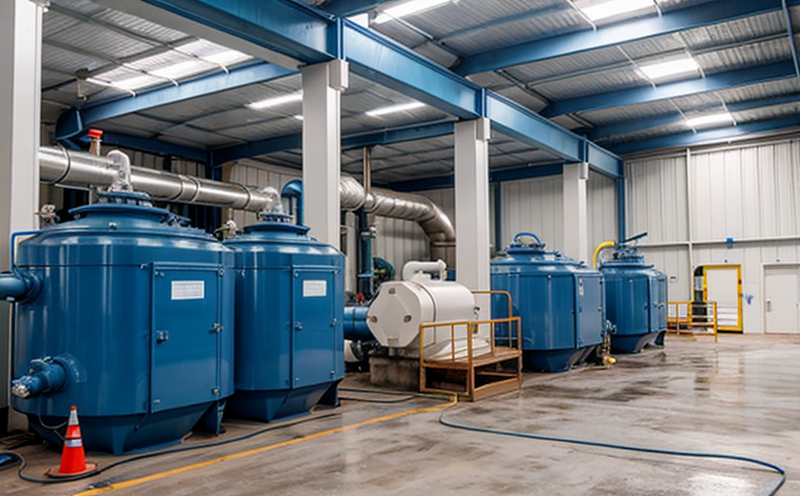USCG Shipboard Testing of Ballast Water Treatment Systems
The United States Coast Guard (USCG) regulations require ships to comply with strict ballast water treatment standards. This ensures the prevention and control of harmful aquatic organisms and pathogens that can be introduced into new ecosystems through ship's ballast water. The testing for compliance involves a rigorous process where specific systems are evaluated on-site aboard vessels.
The USCG-approved test procedure, as specified in 46 CFR Part 153, mandates that the ballast water treatment systems must be tested under real-world conditions aboard the ship. This testing ensures that the system performs effectively in the operational environment it will encounter during maritime travel.
The test involves exposing treated ballast water to a series of stringent criteria designed to simulate the worst-case scenarios encountered by ships at sea. The parameters include but are not limited to:
- Temperature variations from freezing point to ambient temperatures
- Salinity fluctuations within the expected range for oceanic and coastal waters
- Pollutant loadings that simulate various operational conditions
- Different types of organisms, including bacteria, fungi, and microorganisms
The testing process is highly technical, involving precise instrumentation to monitor the performance of the treatment system. The USCG-approved test protocols are designed to ensure that all components function as intended under real-world conditions. This includes checking for:
- Efficiency in removing harmful organisms
- Pollution control compliance with US and international standards
- Compatibility of the treated water with port reception facilities
- Safety of crew members during system operation
The testing process is critical for maintaining compliance with regulatory requirements. It helps ensure that ships are not only safe but also contribute positively to environmental sustainability by preventing the introduction and spread of invasive species.
Failure to comply can result in significant penalties, including fines and operational restrictions. Therefore, it is imperative that ship operators and managers understand the importance of this testing process and take appropriate steps to ensure their systems meet all required standards.
Applied Standards
The USCG Shipboard Testing for Ballast Water Treatment Systems is based on a combination of international, federal, and industry standards. The primary standard used is the USCG's own regulations found in 46 CFR Part 153. This regulation outlines the testing procedures and acceptance criteria for ballast water treatment systems.
In addition to these specific regulations, the International Maritime Organization (IMO) has established guidelines through Resolution MEPC.207(64), which is aligned with the USCG standards. These guidelines provide a framework for ensuring that ships are equipped with effective ballast water management systems.
Other relevant international standards include ISO 19722-3:2018, which provides guidance on the design and performance of ballast water treatment systems. This standard helps ensure that the systems meet the required efficiency levels in removing harmful organisms from ballast water.
The USCG also references ASTM standards for testing and validation processes. For instance, ASTM G154 provides a method for the accelerated laboratory testing of materials exposed to seawater. While this is not directly used in shipboard testing, it supports the broader understanding and validation of treatment system performance.
The combination of these standards ensures that the USCG Shipboard Testing process is both comprehensive and internationally aligned, providing a robust framework for compliance.
Environmental and Sustainability Contributions
- Reduction in Invasive Species Spread: By effectively treating ballast water, the USCG Shipboard Testing helps prevent the introduction of invasive species into new aquatic environments. This reduces ecological damage and economic losses associated with biological invasions.
- Enhanced Water Quality: Compliance with USCG standards ensures that treated ballast water meets environmental quality criteria set by regulatory bodies, contributing to cleaner and healthier marine ecosystems.
- Sustainable Shipping Practices: The testing process promotes sustainable shipping practices by ensuring ships are equipped with the latest technology for managing ballast water, thus supporting long-term ecological health.
Use Cases and Application Examples
The USCG Shipboard Testing of Ballast Water Treatment Systems is widely used across various maritime sectors. Here are some application examples:
- Cargo Ships: Cargo ships, such as container vessels, frequently load and unload ballast water in different ports around the world. Ensuring these systems comply with USCG standards helps prevent the spread of invasive species.
- Tankers: Tankers use ballast water to maintain stability during voyage phases when cargo is not being transported. Compliance testing ensures that any organisms introduced remain contained and do not affect local ecosystems.
- Ferry Services: Ferries, especially those crossing international waters, must adhere to strict regulations regarding ballast water treatment systems. This compliance helps protect coastal waters from invasive species.
The testing process is also crucial for new vessels entering the fleet and existing ones undergoing maintenance or upgrade processes. Ensuring these systems are up-to-date and compliant with current regulations is essential for maintaining operational efficiency and environmental responsibility.





